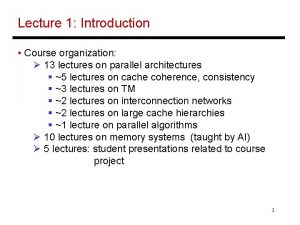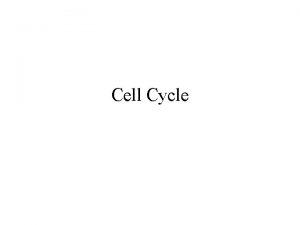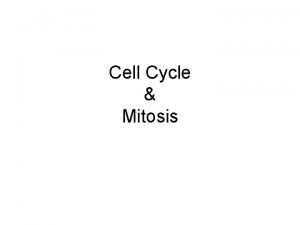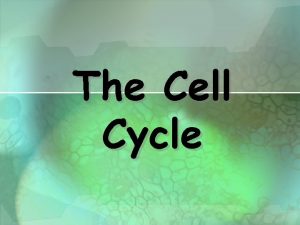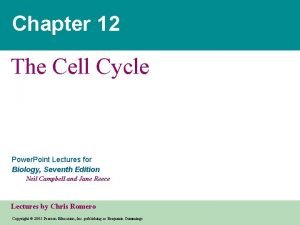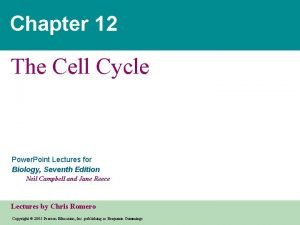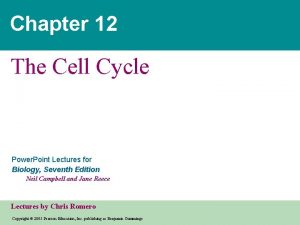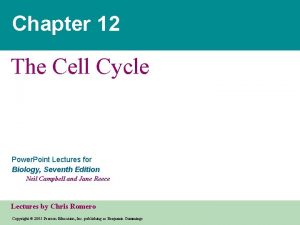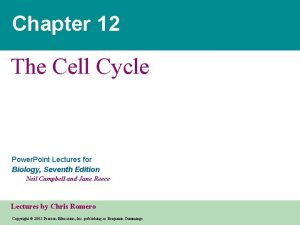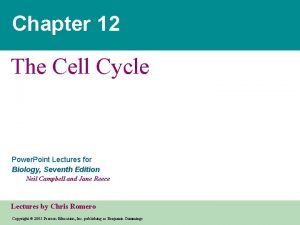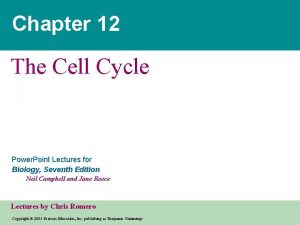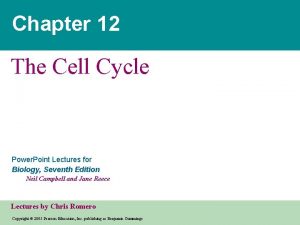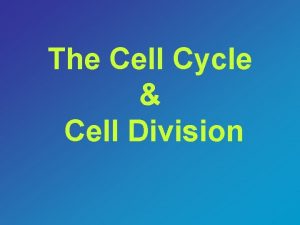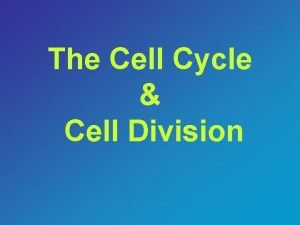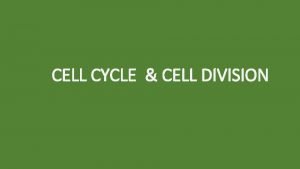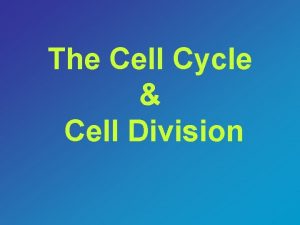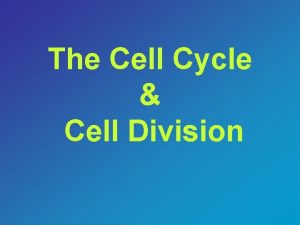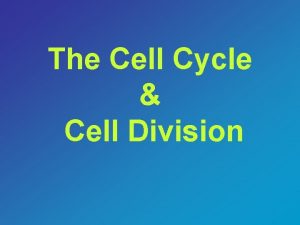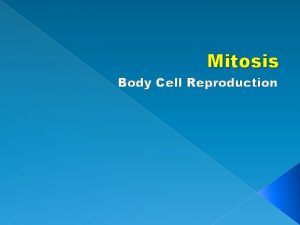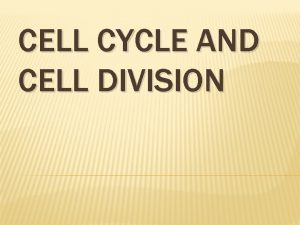Chapter 12 The Cell Cycle Power Point Lectures











































- Slides: 43

Chapter 12 The Cell Cycle Power. Point Lectures for Biology, Seventh Edition Neil Campbell and Jane Reece Lectures by Chris Romero Copyright © 2005 Pearson Education, Inc. publishing as Benjamin Cummings

• Overview: The Key Roles of Cell Division • The continuity of life – Is based upon the reproduction of cells, or cell division Figure 12. 1 Copyright © 2005 Pearson Education, Inc. publishing as Benjamin Cummings

• Unicellular organisms – Reproduce by cell division 100 µm (a) Reproduction. An amoeba, a single-celled eukaryote, is dividing into two cells. Each new cell will be an individual Figure 12. 2 A organism (LM). Copyright © 2005 Pearson Education, Inc. publishing as Benjamin Cummings

• Multicellular organisms depend on cell division for – Development from a fertilized cell – Growth – Repair 200 µm 20 µm (b) Growth and development. (c) Tissue renewal. These dividing This micrograph shows a bone marrow cells (arrow) will sand dollar embryo shortly give rise to new blood cells (LM). after the fertilized egg divided, Figure 12. 2 B, C forming two cells (LM). Copyright © 2005 Pearson Education, Inc. publishing as Benjamin Cummings

• The cell division process – Is an integral part of the cell cycle Copyright © 2005 Pearson Education, Inc. publishing as Benjamin Cummings

• Concept 12. 1: Cell division results in genetically identical daughter cells • Cells duplicate their genetic material – Before they divide, ensuring that each daughter cell receives an exact copy of the genetic material, DNA Copyright © 2005 Pearson Education, Inc. publishing as Benjamin Cummings

Cellular Organization of the Genetic Material • A cell’s endowment of DNA, its genetic information – Is called its genome Copyright © 2005 Pearson Education, Inc. publishing as Benjamin Cummings

• The DNA molecules in a cell – Are packaged into chromosomes Figure 12. 3 50 µm Copyright © 2005 Pearson Education, Inc. publishing as Benjamin Cummings

• Eukaryotic chromosomes – Consist of chromatin, a complex of DNA and protein that condenses during cell division • In animals – Somatic cells have two sets of chromosomes – Gametes have one set of chromosomes Copyright © 2005 Pearson Education, Inc. publishing as Benjamin Cummings

Distribution of Chromosomes During Cell Division • In preparation for cell division – DNA is replicated and the chromosomes condense Copyright © 2005 Pearson Education, Inc. publishing as Benjamin Cummings

• Each duplicated chromosome – Has two sister chromatids, which separate during cell division 0. 5 µm A eukaryotic cell has multiple chromosomes, one of which is represented here. Before duplication, each chromosome has a single DNA molecule. Once duplicated, a chromosome consists of two sister chromatids connected at the centromere. Each chromatid contains a copy of the DNA molecule. Mechanical processes separate the sister chromatids into two chromosomes and distribute them to two daughter cells. Figure 12. 4 Copyright © 2005 Pearson Education, Inc. publishing as Benjamin Cummings Chromosome duplication (including DNA synthesis) Centromere Sister Separation chromatids of sister chromatids Centromeres Sister chromatids

• Eukaryotic cell division consists of – Mitosis, the division of the nucleus – Cytokinesis, the division of the cytoplasm • In meiosis – Sex cells are produced after a reduction in chromosome number Copyright © 2005 Pearson Education, Inc. publishing as Benjamin Cummings

• Concept 12. 2: The mitotic phase alternates with interphase in the cell cycle • A labeled probe can reveal patterns of gene expression in different kinds of cells Copyright © 2005 Pearson Education, Inc. publishing as Benjamin Cummings

Phases of the Cell Cycle • The cell cycle consists of – The mitotic phase – Interphase INTERPHASE S (DNA synthesis) C M yto ito ki si ne s si s G 1 MI (M TOT ) P IC HA SE Figure 12. 5 Copyright © 2005 Pearson Education, Inc. publishing as Benjamin Cummings G 2

• Interphase can be divided into subphases – G 1 phase – S phase – G 2 phase Copyright © 2005 Pearson Education, Inc. publishing as Benjamin Cummings

• The mitotic phase – Is made up of mitosis and cytokinesis Copyright © 2005 Pearson Education, Inc. publishing as Benjamin Cummings

• Mitosis consists of five distinct phases – Prophase – Prometaphase G 2 OF INTERPHASE Centrosomes (with centriole pairs) Chromatin (duplicated) Figure 12. 6 Nucleolus Nuclear Plasma envelope membrane PROPHASE Early mitotic spindle Aster Centromere Chromosome, consisting of two sister chromatids Copyright © 2005 Pearson Education, Inc. publishing as Benjamin Cummings PROMETAPHASE Fragments Kinetochore of nuclear envelope Nonkinetochore microtubules Kinetochore microtubule

– Metaphase – Anaphase – Telophase METAPHASE ANAPHASE Metaphase plate Figure 12. 6 Spindle Centrosome at Daughter one spindle pole chromosomes Copyright © 2005 Pearson Education, Inc. publishing as Benjamin Cummings TELOPHASE AND CYTOKINESIS Cleavage furrow Nuclear envelope forming Nucleolus forming

The Mitotic Spindle: A Closer Look • The mitotic spindle – Is an apparatus of microtubules that controls chromosome movement during mitosis Copyright © 2005 Pearson Education, Inc. publishing as Benjamin Cummings

• The spindle arises from the centrosomes – And includes spindle microtubules and asters Copyright © 2005 Pearson Education, Inc. publishing as Benjamin Cummings

• Some spindle microtubules – Attach to the kinetochores of chromosomes and move the chromosomes to the metaphase plate Aster Sister chromatids Centrosome Metaphase Plate Kinetochores Overlapping nonkinetochore microtubules Kinetochores microtubules Microtubules 0. 5 µm Figure 12. 7 Centrosome 1 µm Copyright © 2005 Pearson Education, Inc. publishing as Benjamin Cummings Chromosomes

Figure 1 Centrioles in Cell Division and Ciliogenesis (Upper panel) During the cell cycle, centrioles replicate and migrate to form the poles of the mitotic spindle, which are necessary for the segregation of chromosomes. However, centriolar dysfunction a. . . Jose L. Badano , Nicholas Katsanis Life without Centrioles: Cilia in the Spotlight Cell Volume 125, Issue 7 2006 1228 - 1230 http: //dx. doi. org/10. 1016/j. cell. 2006. 013 Copyright © 2005 Pearson Education, Inc. publishing as Benjamin Cummings

• In anaphase, sister chromatids separate – And move along the kinetochore microtubules toward opposite ends of the cell EXPERIMENT 1 The microtubules of a cell in early anaphase were labeled with a fluorescent dye that glows in the microscope (yellow). Kinetochore Spindle pole Figure 12. 8 Copyright © 2005 Pearson Education, Inc. publishing as Benjamin Cummings

• Nonkinetechore microtubules from opposite poles – Overlap and push against each other, elongating the cell • In telophase – Genetically identical daughter nuclei form at opposite ends of the cell Copyright © 2005 Pearson Education, Inc. publishing as Benjamin Cummings

Cytokinesis: A Closer Look • In animal cells – Cytokinesis occurs by a process known as cleavage, forming a cleavage furrow Contractile ring of microfilaments Figure 12. 9 A 100 µm Daughter cells (a) Cleavage of an animal cell (SEM) Copyright © 2005 Pearson Education, Inc. publishing as Benjamin Cummings

• In plant cells, during cytokinesis – A cell plate forms Vesicles forming cell plate 1 µm Wall of patent cell Cell plate New cell wall Daughter cells Figure 12. 9 B (b) Cell plate formation in a plant cell (SEM) Copyright © 2005 Pearson Education, Inc. publishing as Benjamin Cummings

• Mitosis in a plant cell Chromatine Nucleus Nucleolus condensing Chromosome 2 Prometaphase. 3 1 Prophase. The chromatin We now see discrete is condensing. chromosomes; each The nucleolus is consists of two beginning to identical sister disappear. chromatids. Later Although not in prometaphase, the yet visible nuclear envelop will in the micrograph, fragment. the mitotic spindle is staring to from. Metaphase. The Anaphase. The 5 spindle is complete, 4 chromatids of each and the chromosomes, chromosome have attached to microtubules separated, and the at their kinetochores, daughter chromosomes are all at the metaphase are moving to the ends plate. of cell as their Figure 12. 10 Copyright © 2005 Pearson Education, Inc. publishing as Benjamin Cummings kinetochore microtubles shorten. Telophase. Daughter nuclei are forming. Meanwhile, cytokinesis has started: The cell plate, which will divided the cytoplasm in two, is growing toward the perimeter of the parent cell.

Binary Fission • Prokaryotes (bacteria) – Reproduce by a type of cell division called binary fission Copyright © 2005 Pearson Education, Inc. publishing as Benjamin Cummings

• In binary fission – The bacterial chromosome replicates – The two daughter chromosomes actively move apart Origin of replication Cell wall E. coli cell 1 Chromosome replication begins. Soon thereafter, one copy of the origin moves rapidly toward the other end of the cell. 2 Replication continues. One copy of the origin is now at each end of the cell. 3 Replication finishes. The plasma membrane grows inward, and new cell wall is deposited. Figure 12. 11 4 Two daughter cells result. Copyright © 2005 Pearson Education, Inc. publishing as Benjamin Cummings Two copies of origin Origin Plasma Membrane Bacterial Chromosome Origin

The Evolution of Mitosis • Since prokaryotes preceded eukaryotes by billions of years – It is likely that mitosis evolved from bacterial cell division • Certain protists – Exhibit types of cell division that seem intermediate between binary fission and mitosis carried out by most eukaryotic cells Copyright © 2005 Pearson Education, Inc. publishing as Benjamin Cummings

• A hypothetical sequence for the evolution of mitosis (a) Prokaryotes. During binary fission, the origins of the daughter chromosomes move to opposite ends of the cell. The mechanism is not fully understood, but proteins may anchor the daughter chromosomes to specific sites on the plasma membrane. (b) Dinoflagellates. In unicellular protists called dinoflagellates, the nuclear envelope remains intact during cell division, and the chromosomes attach to the nuclear envelope. Microtubules pass through the nucleus inside cytoplasmic tunnels, reinforcing the spatial orientation of the nucleus, which then divides in a fission process reminiscent of bacterial division. (c) Diatoms. In another group of unicellular protists, the diatoms, the nuclear envelope also remains intact during cell division. But in these organisms, the microtubules form a spindle within the nucleus. Microtubules separate the chromosomes, and the nucleus splits into two daughter nuclei. (d) Most eukaryotes. In most other eukaryotes, including plants and animals, the spindle forms outside the nucleus, and the nuclear envelope breaks down during mitosis. Microtubules separate the chromosomes, and the nuclear envelope then re-forms. Figure 12. 12 A-D Copyright © 2005 Pearson Education, Inc. publishing as Benjamin Cummings Bacterial chromosome Chromosomes Microtubules Intact nuclear envelope Kinetochore microtubules Centrosome Fragments of nuclear envelope

• Concept 12. 3: The cell cycle is regulated by a molecular control system • The frequency of cell division – Varies with the type of cell • These cell cycle differences – Result from regulation at the molecular level Copyright © 2005 Pearson Education, Inc. publishing as Benjamin Cummings

Evidence for Cytoplasmic Signals • Molecules present in the cytoplasm – Regulate progress through the cell cycle EXPERIMENTS In each experiment, cultured mammalian cells at two different phases of the cell cycle were induced to fuse. Experiment 1 Experiment 2 S G 1 M S M G 1 RESULTS S When a cell in the S phase was fused with a cell in G 1, the G 1 cell immediately entered the S phase—DNA was synthesized. M When a cell in the M phase was fused with a cell in G 1, the G 1 cell immediately began mitosis— a spindle formed and chromatin condensed, even though the chromosome had not been duplicated. CONCLUSION The results of fusing cells at two different phases of the cell cycle suggest that molecules present in the Figure 12. 13 A, B cytoplasm of cells in the S or M phase control the progression of phases. Copyright © 2005 Pearson Education, Inc. publishing as Benjamin Cummings

The Cell Cycle Control System • The sequential events of the cell cycle – Are directed by a distinct cell cycle control system, which is similar to a clock G 1 checkpoint Control system G 1 M G 2 M checkpoint Figure 12. 14 Copyright © 2005 Pearson Education, Inc. publishing as Benjamin Cummings G 2 checkpoint S

• The clock has specific checkpoints – Where the cell cycle stops until a go-ahead signal is received G 0 G 1 checkpoint G 1 Figure 12. 15 A, B (a) If a cell receives a go-ahead signal at the G 1 checkpoint, the cell continues on in the cell cycle. Copyright © 2005 Pearson Education, Inc. publishing as Benjamin Cummings G 1 (b) If a cell does not receive a go-ahead signal at the G 1 checkpoint, the cell exits the cell cycle and goes into G 0, a nondividing state.

The Cell Cycle Clock: Cyclins and Cyclin-Dependent Kinases • Two types of regulatory proteins are involved in cell cycle control • Cyclins and cyclin-dependent kinases (Cdks) Copyright © 2005 Pearson Education, Inc. publishing as Benjamin Cummings

• The activity of cyclins and Cdks – Fluctuates during the cell cycle (a) Fluctuation of MPF activity and cyclin concentration during the cell cycle M G 1 S G 2 M MPF activity Cyclin Time (b) Molecular mechanisms that help regulate the cell cycle 1 Synthesis of cyclin begins in late S phase and continues through G 2. Because cyclin is protected from degradation during this stage, it accumulates. G 4 During anaphase, the cyclin component of MPF is degraded, terminating the M phase. The cell enters the G 1 phase. Copyright © 2005 Pearson Education, Inc. publishing as Benjamin Cummings 2 G Degraded Cyclin is degraded Figure 12. 16 A, B S Cdk M the cell favor degradation of cyclin, and the Cdk component of MPF is recycled. 1 5 During G 1, conditions in G 2 Cdk checkpoint MPF Cyclin 2 Accumulated cyclin molecules combine with recycled Cdk molecules, producing enough molecules of MPF to pass the G 2 checkpoint and initiate the events of mitosis. 3 MPF promotes mitosis by phosphorylating various proteins. MPF‘s activity peaks during metaphase.

Stop and Go Signs: Internal and External Signals at the Checkpoints • Both internal and external signals – Control the cell cycle checkpoints Copyright © 2005 Pearson Education, Inc. publishing as Benjamin Cummings

• Growth factors – Stimulate other cells to divide EXPERIMENT Scalpels 1 A sample of connective tissue was cut up into small pieces. Petri plate 2 Enzymes were used to digest the extracellular matrix, resulting in a suspension of free fibroblast cells. 3 Cells were transferred to sterile culture vessels Figure 12. 17 containing a basic growth medium consisting of glucose, amino acids, salts, and antibiotics (as a Without PDGF precaution against bacterial growth). PDGF was added to half the vessels. The culture vessels were incubated at 37°C. With PDGF Copyright © 2005 Pearson Education, Inc. publishing as Benjamin Cummings

• In density-dependent inhibition – Crowded cells stop dividing • Most animal cells exhibit anchorage dependence – In which they must be attached to a substratum to divide (a) Normal mammalian cells. The availability of nutrients, growth factors, and a substratum for attachment limits cell density to a single layer. Cells anchor to dish surface and divide (anchorage dependence). When cells have formed a complete single layer, they stop dividing (density-dependent inhibition). If some cells are scraped away, the remaining cells divide to fill the gap and then stop (density-dependent inhibition). Figure 12. 18 A Copyright © 2005 Pearson Education, Inc. publishing as Benjamin Cummings 25 µm

• Cancer cells – Exhibit neither density-dependent inhibition nor anchorage dependence Cancer cells do not exhibit anchorage dependence or density-dependent inhibition. (b) Cancer cells usually continue to divide well beyond a single layer, forming a clump of overlapping cells. Figure 12. 18 B 25 µm Copyright © 2005 Pearson Education, Inc. publishing as Benjamin Cummings

Loss of Cell Cycle Controls in Cancer Cells • Cancer cells – Do not respond normally to the body’s control mechanisms – Form tumors Copyright © 2005 Pearson Education, Inc. publishing as Benjamin Cummings

• Malignant tumors invade surrounding tissues and can metastasize – Exporting cancer cells to other parts of the body where they may form secondary tumors Lymph vessel Tumor Blood vessel Glandular tissue 1 A tumor grows from a single cancer cell. Cancer cell 2 Cancer cells invade neighboring tissue. Figure 12. 19 Copyright © 2005 Pearson Education, Inc. publishing as Benjamin Cummings 3 Cancer cells spread through lymph and blood vessels to other parts of the body. Metastatic Tumor 4 A small percentage of cancer cells may survive and establish a new tumor in another part of the body.
 Molecular biology lectures
Molecular biology lectures Power system lectures
Power system lectures Section 10-2 cell division
Section 10-2 cell division Cell cycle and cell division
Cell cycle and cell division Biology.arizona.edu/cell bio/activities/cell cycle/01.html
Biology.arizona.edu/cell bio/activities/cell cycle/01.html Cell cycle phases
Cell cycle phases Ac power formula
Ac power formula Power bi training powerpoint
Power bi training powerpoint Point point power
Point point power Chapter 4 cell theory and cell study
Chapter 4 cell theory and cell study Rick trebino lectures
Rick trebino lectures Neonatology lectures
Neonatology lectures Data mining lectures
Data mining lectures Medicinal chemistry lectures
Medicinal chemistry lectures Uva powerpoint template
Uva powerpoint template Ludic space
Ludic space Software project management lectures
Software project management lectures Radio astronomy lectures
Radio astronomy lectures Dr sohail lectures
Dr sohail lectures Utilities and energy lectures
Utilities and energy lectures Web engineering lectures ppt
Web engineering lectures ppt Do words have power
Do words have power Frcr physics lectures
Frcr physics lectures Heel effect
Heel effect Introduction to recursion
Introduction to recursion Differentiation of rbc
Differentiation of rbc Define aerodynamics
Define aerodynamics Theory of translation lectures
Theory of translation lectures Theory and practice of translation lectures
Theory and practice of translation lectures Translation 1
Translation 1 Digital logic design lectures
Digital logic design lectures Kurose
Kurose Hegel romantic art
Hegel romantic art Nuclear medicine lectures
Nuclear medicine lectures Recursive fractals c++
Recursive fractals c++ Cdeep lectures
Cdeep lectures Oral communication 3 lectures text
Oral communication 3 lectures text C programming and numerical analysis an introduction
C programming and numerical analysis an introduction Haematology lectures
Haematology lectures Bureau of lectures
Bureau of lectures Slagle lecture
Slagle lecture Theory of translation lectures
Theory of translation lectures Reinforcement learning lectures
Reinforcement learning lectures 13 lectures
13 lectures











































